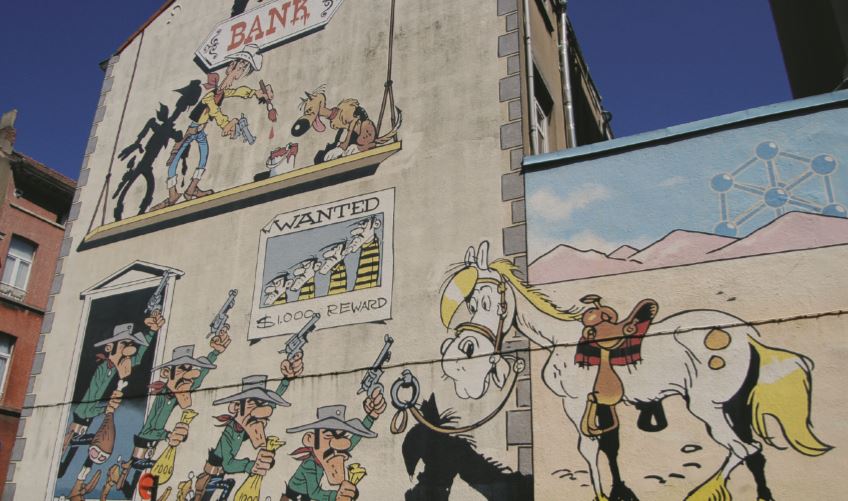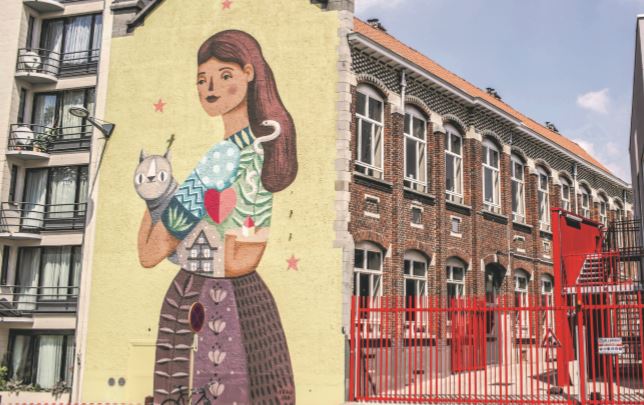- Daily & Weekly newsletters
- Buy & download The Bulletin
- Comment on our articles
Look up: Brussels' walls are a feast for the eyes
The walls of Brussels are covered in art, from decorated facades and strip cartoon murals to street art and creative graffiti. There’s something to see in almost every part of the city.
A glance around the Grand’Place is enough to show that decorated walls are part of Brussels’ heritage. Rebuilt in the late 17th century after the square suffered a catastrophic bombardment, the buildings are covered in gold ornamentation and symbols of the guilds that once occupied them. Meanwhile, in a side street, an Art Nouveau basrelief pays tribute to the architects involved, providing a neat link to the architectural extravagance of the late 19th and early 20th centuries.
While most Art Nouveau facades build on natural shapes and patterns, the Maison Cauchie, near Cinquantenaire Park, has a more pictorial approach. Its golden facade is busy with figures in flowing robes, a combination of classical references and themes personal to the painter Paul Cauchie and his wife, Carolina Voet. Built in 1905 as a home and a studio, the motto in the centre of the facade reads ‘By Us, For Us’.
Also impressive is the Maison Ciamberlani on Rue Defacqz, designed by Paul Hankar in 1897 for the painter Albert Ciamberlani. The mural elements include the Three Ages of Man around the windows and a frieze above retelling the Labours of Hercules.
The murals that tend to make the greatest impression on visitors to Brussels are those based on comic strips. Usually on the high end walls of buildings, these feature some of the world’s best known cartoon characters. Tintin, Snowy and Captain Haddock descend a painted fire escape on Rue de l’Etuve, while Asterix, Obelix and a village full of Gauls attack a Roman camp on Rue de la Buanderie. Further down the street, Lucky Luke interrupts the Dalton Gang robbing a bank.

Other cartoon murals are devoted to characters whose fame is more national than international, such as Suske and Wiske or Gaston Lagaffe. Then there are murals for strips devoted to crime and action: Corto Maltese, The Scorpion and Blake & Mortimer.
Several of these murals play games with the city environment, reflecting the surrounding streets or commenting on the passage of time. The most involved are connected with François Schuiten, a comic artist obsessed with the Brussels landscape. Check out The Passage on Rue du Marché au Charbon or L’Arche on Chaussée d’Ixelles.
The Comic Strip Walk promoted by tourist agency Visit Brussels will take you around 23 cartoon murals in the city centre, with shorter circuits in Laeken, Sablon and the Marolles. A useful guide is also provided by the non-profit organisation Art Mural, which produced most of the murals and continues to decorate walls around Belgium.
One project involves painting 28 murals between Parc Royal and the European Parliament, each inspired by a cartoonist from a different EU member state. Two have been completed so far: Couleur Café by the Belgian artist Judith Vanistendael at Place SaintJosse, and La Bambina Magritta by the Italian Vanna Vinci, at Rue du Marteau. The initiative will also address the male bias in the older comic strip murals.

Brussels also has a lot of street art, both officially sanctioned and freerange graffiti. Last year’s Mixity Wall is one example, a project from non-profit Urbana to put up eight murals on themes of urban diversity across the city. The six completed so far are mainly off the beaten track, but worth a detour if you are in the neighbourhood. For example, Spanish artist Okuda’s colourful, geometric figures support the world on Place Saint-Lazare, on the ugly side of North station, while Frau Isa from Austria depicts the capital of Europe as a calm woman with a cat in her arms and her heart on her sleeve. Find it on Boulevard du Triomphe, near the ULB and VUB university campuses.
Another non-profit promoting Brussels street art is Une Ville en Couleur. It’s behind the beautiful, folk-tinged mural Mother by Polish street artist Sainer, on Rue Simon Bolivar in the business district around North station, and Pso Man’s dynamic Auderghem library mural, a running hare with a futuristic city on its back.
The wilder side of Brussels street art is best represented by Vincent Glowinski, aka Bonom, who specialises in giant images of animals or skeletons. These often appear fleetingly on construction sites or buildings awaiting demolition, but others have endured. An image of an emaciated old man high on a building at Porte de Hal is particularly impressive, while the Generali Building opposite Bozar features a skeleton dinosaur menacing a tiny Manneken Pis.
Then there are the pencils, witty variations on a simple sprayed image that continue to appear across the city. Collectors have photographed hundreds of them, tracing the trends and jokes traded by the graffiti artists responsible. Long may they spray.
This article first appeared in The Bulletin Spring 2018


















